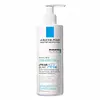What's inside
What's inside
 Key Ingredients
Key Ingredients

 Benefits
Benefits

 Concerns
Concerns

 Ingredients Side-by-side
Ingredients Side-by-side

Water
Skin ConditioningPEG-8
HumectantLauryl Betaine
CleansingSodium Laureth Sulfate
CleansingHexylene Glycol
EmulsifyingSodium Chloride
MaskingPEG-120 Methyl Glucose Dioleate
EmulsifyingSodium Cocoamphoacetate
CleansingP-Anisic Acid
MaskingCitric Acid
BufferingDecyl Glucoside
CleansingTetrasodium EDTA
Sodium Benzoate
MaskingButylene Glycol
HumectantLinalool
PerfumingLimonene
PerfumingCapryloyl Salicylic Acid
ExfoliatingCitronellol
PerfumingLaminaria Saccharina Extract
Skin ProtectingVitreoscilla Ferment
Skin ConditioningZinc Sulfate
AntimicrobialZea Mays Oil
EmulsifyingPrunus Armeniaca Kernel Oil
MaskingPassiflora Edulis Seed Oil
EmollientOryza Sativa Bran Oil
EmollientPyridoxine Hcl
Skin ConditioningTocopherol
AntioxidantAscorbyl Palmitate
AntioxidantSodium Hydroxide
BufferingParfum
MaskingCI 19140
Cosmetic ColorantCI 17200
Cosmetic ColorantWater, PEG-8, Lauryl Betaine, Sodium Laureth Sulfate, Hexylene Glycol, Sodium Chloride, PEG-120 Methyl Glucose Dioleate, Sodium Cocoamphoacetate, P-Anisic Acid, Citric Acid, Decyl Glucoside, Tetrasodium EDTA, Sodium Benzoate, Butylene Glycol, Linalool, Limonene, Capryloyl Salicylic Acid, Citronellol, Laminaria Saccharina Extract, Vitreoscilla Ferment, Zinc Sulfate, Zea Mays Oil, Prunus Armeniaca Kernel Oil, Passiflora Edulis Seed Oil, Oryza Sativa Bran Oil, Pyridoxine Hcl, Tocopherol, Ascorbyl Palmitate, Sodium Hydroxide, Parfum, CI 19140, CI 17200
Water
Skin ConditioningButyrospermum Parkii Butter
Skin ConditioningGlycerin
HumectantDimethicone
EmollientNiacinamide
SmoothingCetearyl Alcohol
EmollientBrassica Campestris Seed Oil
Skin ConditioningGlyceryl Stearate
EmollientAmmonium Polyacryloyldimethyl Taurate
Emulsion StabilisingPEG-100 Stearate
Propanediol
SolventOphiopogon Japonicus Root Extract
Skin ConditioningPEG-20 Methyl Glucose Sesquistearate
EmulsifyingSorbitan Tristearate
EmulsifyingDimethiconol
EmollientSodium Chloride
MaskingMannose
HumectantCoco-Betaine
CleansingDisodium EDTA
Capryloyl Glycine
CleansingCaprylyl Glycol
EmollientVitreoscilla Ferment
Skin ConditioningCitric Acid
BufferingMaltodextrin
AbsorbentXanthan Gum
EmulsifyingTocopherol
AntioxidantPentaerythrityl Tetra-Di-T-Butyl Hydroxyhydrocinnamate
AntioxidantWater, Butyrospermum Parkii Butter, Glycerin, Dimethicone, Niacinamide, Cetearyl Alcohol, Brassica Campestris Seed Oil, Glyceryl Stearate, Ammonium Polyacryloyldimethyl Taurate, PEG-100 Stearate, Propanediol, Ophiopogon Japonicus Root Extract, PEG-20 Methyl Glucose Sesquistearate, Sorbitan Tristearate, Dimethiconol, Sodium Chloride, Mannose, Coco-Betaine, Disodium EDTA, Capryloyl Glycine, Caprylyl Glycol, Vitreoscilla Ferment, Citric Acid, Maltodextrin, Xanthan Gum, Tocopherol, Pentaerythrityl Tetra-Di-T-Butyl Hydroxyhydrocinnamate
 Reviews
Reviews

Ingredients Explained
These ingredients are found in both products.
Ingredients higher up in an ingredient list are typically present in a larger amount.
Citric Acid is an alpha hydroxy acid (AHA) naturally found in citrus fruits like oranges, lemons, and limes.
Like other AHAs, citric acid can exfoliate skin by breaking down the bonds that hold dead skin cells together. This helps reveal smoother and brighter skin underneath.
However, this exfoliating effect only happens at high concentrations (20%) which can be hard to find in cosmetic products.
Due to this, citric acid is usually included in small amounts as a pH adjuster. This helps keep products slightly more acidic and compatible with skin's natural pH.
In skincare formulas, citric acid can:
While it can provide some skin benefits, research shows lactic acid and glycolic acid are generally more effective and less irritating exfoliants.
Most citric acid used in skincare today is made by fermenting sugars (usually from molasses). This synthetic version is identical to the natural citrus form but easier to stabilize and use in formulations.
Read more about some other popular AHA's here:
Learn more about Citric AcidChances are, you eat sodium chloride every day. Sodium Chloride is also known as table salt.
This ingredient has many purposes in skincare: thickener, emulsifier, and exfoliator.
You'll most likely find this ingredient in cleansers where it is used to create a gel-like texture. As an emulsifier, it also prevents ingredients from separating.
There is much debate on whether this ingredient is comedogenic. The short answer - comedogenic ratings don't tell the whole story. Learn more about comegodenic ratings here.
The concensus about this ingredient causing acne seems to be divided. Research is needed to understand if this ingredient does cause acne.
Scrubs may use salt as the primary exfoliating ingredient.
Learn more about Sodium ChlorideTocopherol (also known as Vitamin E) is a common antioxidant used to help protect the skin from free-radicals and strengthen the skin barrier. It's also fat soluble - this means our skin is great at absorbing it.
Vitamin E also helps keep your natural skin lipids healthy. Your lipid skin barrier naturally consists of lipids, ceramides, and fatty acids. Vitamin E offers extra protection for your skin’s lipid barrier, keeping your skin healthy and nourished.
Another benefit is a bit of UV protection. Vitamin E helps reduce the damage caused by UVB rays. (It should not replace your sunscreen). Combining it with Vitamin C can decrease sunburned cells and hyperpigmentation after UV exposure.
You might have noticed Vitamin E + C often paired together. This is because it is great at stabilizing Vitamin C. Using the two together helps increase the effectiveness of both ingredients.
There are often claims that Vitamin E can reduce/prevent scarring, but these claims haven't been confirmed by scientific research.
Learn more about TocopherolVitreoscilla Ferment is a probiotic derived from the Vitreoscilla bacteria.
Studies show Vitreoscilla Ferment to have the same benefits as ingesting probiotics. Probiotics help keep the bacteria in your body healthy.
In general, maintaining a healthy microbiome on your skin has many benefits. One benefit is protection against external and bad bacteria. A healthy microbiome also helps maintain skin hydration and reduce inflammation.
Probiotics work best when combined with prebiotics.
Learn more about Vitreoscilla FermentWater. It's the most common cosmetic ingredient of all. You'll usually see it at the top of ingredient lists, meaning that it makes up the largest part of the product.
So why is it so popular? Water most often acts as a solvent - this means that it helps dissolve other ingredients into the formulation.
You'll also recognize water as that liquid we all need to stay alive. If you see this, drink a glass of water. Stay hydrated!
Learn more about Water